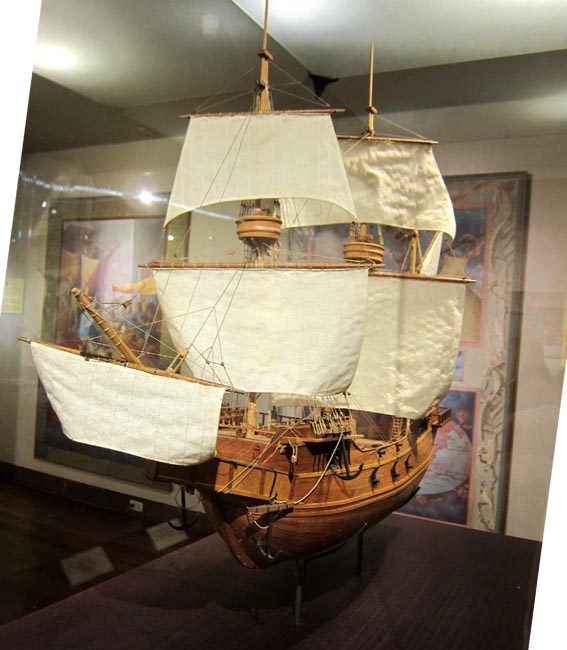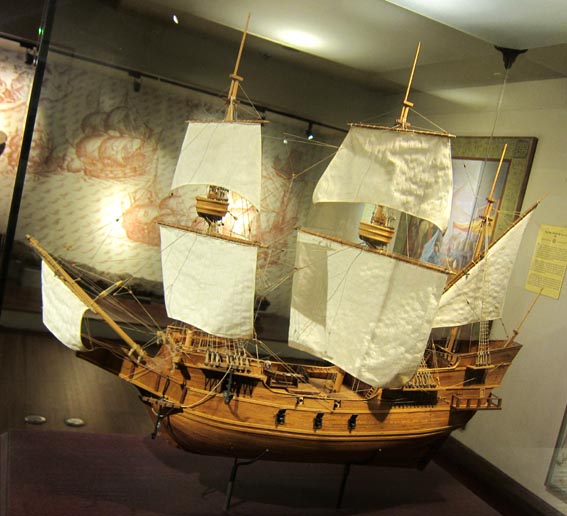一枚の特選フォト⌈海 & 船⌋
One Selected Photo "Oceans & Ships"
Back to: Top Page |
ガレオン船サンディエゴ号 (その2)
~ マニラ・ガレオン船交易ルートの発展 ~ [フィリピン国立民族学博物館]
1
2
|
"Mr. Robert Carpentier built the model of San Diego in 1995 under the Scientific Director Mr. Michel L'Hour and
Mr. Michel Daeffer. 1/50 Scale Model" マニラの国立民族学博物館 (National Museum of Anthropology) に展示されるこのガレオン船(サンディエゴ号)模型は、 1995年にRobert Carpentierによって製作された。縮尺:1/50。 |
|
画像1&2はフィリピンのマニラ市内にある国立民族学博物館に展示されるスペインのサンディエゴ号」の模型である。
サンディエゴ号は、1590年にマニラで建造された3本マスト・積載量700トンのガレオン船である。
同船は貿易船であったが、後に大砲14門が搭載されるなど、軍船に改装された。展示では、その改装年代は不詳である。
1600年12月14日に、オランダの海賊船「モーリシャス号」との戦闘において、マニラ湾外のマニラ南西にあるフォーテュン島
(Fortune Island) の沖1.4km辺りで沈没した。
サンディエゴ号が貿易のためにマニラとヌエバ・エスパーニャ副王領 (メキシコ) のアカプルコとの間を、その建造以来どの程度行き 来した貿易船なのか。いわゆるマニラ・ガレオン船というるのかどうか、展示パネルでは何も触れられておらず、 その点は不詳といわざるをえない。だがしかし、展示室ではマニラ・ガレオン船のことや、マニラ~アカプルコ間の太平洋横断交易に 関して多くの説明が割かれている。それを鑑みれば、サンディエゴ号はマニラ・ガレオン船であったと認識されているもの と推察される。 閑話休題。マニラ・ガレオン船や太平洋横断交易に関する展示パネルの記載内容についていつまんで紹介したい。
(1) マニラ・ガレオン その新しい海のルートはフィリピン群島をアメリカ大陸に結び付け、新しい植民化の時代を開くことことになった。ミゲル・ロペス・デ・ レガスピー(Miguel Lopez de Legazpi)はルソンの征服を行なった。マニラは1571年に創建され、マニラを中心にして利益が生み 出されるという太平洋をまたいだ交易が始まった。
1573年になって2隻のガレオン船が毎年アカプルコから船出するようになった。そして絹織物、スパイス、陶磁器などを満載して
マニラから復航した。ペルーで採掘されメキシコで鋳造(minted)された銀から造られたスペインのダブロン金貨が中国の明皇帝の
国庫に流れ、それによって帝国は世界経済に組み込まれた。
After the first circumnavigation of the globe in 1525, it was decided that the "Spice Islands” would be given to Portugal, and that the Islas de San Lazaro would be given to Spain. Nevertheless, for the next four decades the Philippines would be connected to Spain only by the tenuous link of occasional expeditions. The west-to- east maritime route was not discovered until the voyage of Andres de Urdaneta in 1565. The new ocean route linked the archipelago to the American continent. A new era of colonization began. Miguel Lopez de Legazpi undertook the conquest of Luzon. Manila was established in 1571. Thus began a profitable trans-Pacific trade, with Manila at the center. Beginning in 1573, two galleons sailed from Acapaulco each year, and returned from Manila laden with silk, spices and porcelains. Spanish doubloons, made from silver mined in Peru and minted in Mexico, flowed in the coffers of the Ming emperors, whose empire thereby entered the world economy."
(2) ヨーロッパと東洋 カタイ(Cathay 中国)、ジパング(Xipangu 日本)、インドなどの豊かさについてのマルコポーロの話は、コロンブスの西廻りの航海 へとつながった。ムーア人の勢力拡張によって、陸の東西ルートでの交易は妨害されたことから、スペインとポルトガルは代替の 海上ルートを模索することを余儀なくされた。マゼランは世界周航によって新しいルートを発見した。 このルートは絹、スパイス、陶磁器などを含むさらに多くの品々をヨーロッパにもたらすことになった。 1494年のトルデシリャス条約(Treaty of Tordesillas) によって、世界では当時知られていなかったアメリカと太平洋を含む西半球を スペインに、そして東南アジアを含む東半球をポルトガルに二分割した。だが、英国、フランス、オランダが彼ら自身の探検を 組織することになり、その二分割は長くは続かなかった。
Europe's fascination with the legendary nations of the East and the "wonders of the Orient" paved the way for the successful establishment of land routes where Chinese silk was able to reach Rome. The "Silk road" network between China and the Middle East did not only mean trading of luxury goods but also the exchange of religious ideas, art, literature and technical knowledge. The accounts of Marco Polo about the riches of Cathay (China), Xipangu (Japan) and India became the incentive for Columbus' westward voyage. With the Moor's expansion travel via this route was hindered, Spain and Portugal were forced to seek alternative sea routes. Magellan discovered the new route by circumnavigating the world. This route allowed for more goods, including spices, porcelain and silk to be brought to Europe. Through the Treaty of Tordesillas (1494) the world was divided into a western Spanish part that included the America and the Pacific Ocean that was unknown at that time and an eastern Portuguese part that included Southeast Asia. This, however, did not last long because England, France and Holland decided to organize their own expeditions.
メキシコやペルーの海岸と、新領地とされるフィリピンのそれとの間に横たわる海は「スペインの湖」と知られるようになった。 スペインの湖は、そこでの卓越風や海流を利用したガレオン船の交易ルートへと発展し、その交易に役立った。 1565年から1813年まで、ガレオン船がそのスペインの湖を行き来した。 アカプルコから西廻りの航海は2月または3月までに始まり、赤道に沿ったルートをたどり、3か月間を要した。マニラからアカプルコへの 復航は、6月または7月までに出帆し、往航の2倍の期間を要した。年間を通じて最大4隻が用いられた。 スペイン商船は、南米の鉱山で採掘された銀を中国に輸出するためにインド人奴隷を使役した。銀と交換された陶磁器、絹、スパイスなどの 豪奢で得難い品がメキシコに輸送された。それら商品は、荷運び用のらばの隊列 (mule trains) をもってアカプルコから陸路でカリブ海側の港市 ベラクルスまで運ばれ、さらに船でスペインのセビーリャなどへ運ばれた。
The bodies of water between the coast of Mexico and Peru and the new territory, the Philippines, became known as the "Spanish Lake". It served as the route for the galleon trade that made use of the winds and sea currents prevailing in the area. From 1565 through 1813, ships crossed this Spanish Lake. Westward voyages from Acapulco began by February or March and took three months that followed a route along the equator. The return trip from Manila to Acapulco, would in turn leave by June or July and took twice as long. Up to four ships were used all year round. Spanish merchants used Indian slaves to extract silver from South American mines for export China and in return, luxury goods, including porcelain, silk and spices were sent to Mexico. Mule trains were used to transport the goods over land from Acapulco to Vera Cruz where they were shipped off to Seville and other places."
Eurasia is a single land mass which extends from Korean to Spain. Its inhabitants have been in contact with one another since ancient times. " Alexander the Great's military expedition to India in the 14th Century B.C. and diplomatic missions dispatched by the Emperor Han Wudi in the 2nd Century A.D. are two of the earliest examples in a long history of political and military contacts. At the beginning of the modern era, two routes were established: one overland, the SILKROAD, and the other by sea, THE SPICE ROUTE. The Silk Road had been one of the most important arteries of communication since appropriately the year 1000, while the Spice Route grew in importance, especially during the Renaissance.
|
Back to: Top Page |